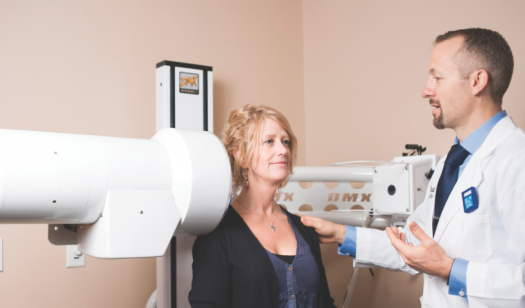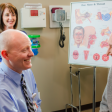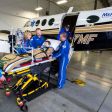

 Spring '24 Issue - Best Of Winners Announced & More
Spring '24 Issue - Best Of Winners Announced & More 
Wednesday, January 13, 2016
Medical Masters - Quality health care across Southern Oregon
Medical Masters
Quality health care across Southern Oregon
Story by Lynn Leissler
Photography by Ezra Marcos
Introduction
People in other parts of the state sometimes express concern that their Southern Oregon loved ones won’t receive quality medical care. They are mistaken! Some regional facilities, or departments within facilities, rank among the top in the nation. Other entities or individuals have participated in breakthrough innovations. If you need care, there is no need to pack your bags and head elsewhere, for help is available in our own backyard.
Throughout the region, opportunity abounds to learn about staying healthy. But if something happens, many qualified and diverse healthcare and wellness providers stand ready to serve you.
Asante
Maternal Fetal Medicine Clinic
Less than a hundred years ago, a mother with a high-risk pregnancy had little hope. The outcome was often the death of mother and/or child. Many women died from what was called childbed fever, due to infection after childbirth. With the advent of antibiotics, such fever-related deaths became comparatively rare. As medical care advanced and doctors grew to better understand the human body, fewer mothers and babies died. In more recent times, care was focused on a successful pregnancy. Now, at Asante’s Maternal Fetal Medical Clinic (MFM), doctors deal not only with health issues involving the pregnancy, but they also study the impact of the pregnancy on the mother’s lifelong health, such as diabetes concerns.
A high-risk pregnancy can involve fetuses at risk due to chromosomal or congenital abnormalities, maternal disease, infection, genetic diseases, and growth restriction. The mother may have heart or kidney disease, hypertension or diabetes. In either situation, the mother is seen more often and undergoes testing to monitor the baby’s and her progress. Mothers carrying multiple babies are more closely monitored. Dr. Leah Bernard says that MFM sees triplets born about once a year.
MFM usually doesn’t deliver babies, but consults with Ob/Gyn doctors, midwives, and primary care physicians to help them manage their high-risk pregnancy patients. They offer both general and high-risk ultrasounds, genetic testing and counseling, and help formulate plans when there are maternal and fetal problems. Today, it is possible to perform procedures on babies in utero. If drug addiction is involved, the normal stress of pregnancy on a woman’s body is increased, posing unique dangers to mother and child. The drug issue has to be handled with the baby in mind, but also the mother in order to keep her relapse possibilities down, which would cause further problems. Dr. Leah Bernard sees a lot of happy endings, although not always. In the sadder cases, she knows she has done her best. “I love what I do,” she says.
Dr. Kahn recently relocated from the Los Angeles area, and discovered that patients in each region worry about different things. Here, when parents receive a diagnosis such as Down syndrome, they are shocked, of course, but then start exploring how they will navigate life with this new little person. He also says the rate of pregnant mothers who smoke is higher in the Rogue Valley. Dr. Kahn likes this area, noting that people don’t drive as crazy as they do in Southern California.
As Dr. Bernard says, “Hopefully people don’t have to meet us, because we’re here for complications or bad diagnoses.” But that’s exactly the point—they are there, the only group in the region to address maternal medical complications. MFM’s goal is to reduce the rate of maternal mortality (death) and maternal morbidity (medical complications of pregnancy, labor, or delivery affecting the mother), as well as the death of babies before, during or after birth, and to do all they can to insure the best health outcomes for both mother and child.
Maternal Fetal Medicine Clinic (Asante)
2911 Siskiyou Blvd., Medford
541-789-5982
www.asante.org
Sky Lakes Medical Center
Wellness Center
Two-thirds of adults and a third of children in our country are overweight or obese. Our weight problem has reached epidemic levels, leading to a multitude of lifestyle diseases—diabetes (of massive proportions), cholesterol, high blood pressure. Not simply minor medical inconveniences, these are now America’s leading causes of death. Primary care physician Dr. Stephanie Van Dyke experienced frustration at being unable to help, other than prescribe medication. Her frustration led her to obtain a MPH (Masters of Public Health), then approach Sky Lakes Medical Center about creating a wellness center. In March of 2015 Sky Lakes Wellness Center (SLWC) started seeing patients.
Losing weight is hard, but keeping it off is often harder. Simply knowing healthy habits doesn’t mean people adopt them. Aware of this, Dr. Van Dyke and nurse Katherine Pope studied successful models before launching a comprehensive weight-loss program. The program currently serves only Sky Lakes Medical Center employees, but will open to the community in 2016.
Jeanette Rutherford, a behavior therapist, and Jennifer Lehman, a dietician and certified diabetes educator, are part of the team, and administrative assistant Stephanie Scott manages the office. Patients meet with the providers before joining the group setting. Groups allow sharing, encouragement, and accountability, and meet weekly for a month, then monthly for the last half of the program. Participants learn healthy, manageable changes, laying a foundation for lifelong dietary and physical activity success.
“The results are significant,” Dr. Van Dyke says, “and the team is thrilled.” They are seeing decreases in weight, BMI (body mass index), abdominal fat, diabetes, cholesterol and blood pressure. People are getting off medications, sleeping better, and having more energy. With better physical health comes better emotional health, a sense of empowerment and self-confidence. Depression is often lessened.
The Blue Zones project is part of SLWC’s outreach, a program that gathers data from groups or regions where people live exceptionally long lives, then applies the concepts to the U.S. We will write more in the spring about Klamath Fall’s Blue Zones project.
Van Dyke and Pope are working to develop bike paths in Klamath Falls. Sometimes people are afraid to ride a bike, but a path with protection such as planters or posts lends security and allows community members to feel safe riding to work or patronizing local businesses. Bike paths also improve a community’s economy.
Lehman recently launched a teaching kitchen. People might acknowledge the need to eat better, but knowing how to cook meals that are both good for you and appetizing goes a long way toward nutrition and healthy cooking at home. A fitness room is projected to be complete in March of 2016, which will offer circuit training and yoga, as well as stress-mindfulness classes guided by Rutherford.
Dr. Van Dyke speaks with enthusiasm, excited to participate in improving her community’s physical and emotional health. She is thrilled to be part of a multidisciplinary team that is pushing the boundaries of healthcare and leading an innovative approach to preventative healthcare.
Sky Lakes Wellness Center
128 South 11th St., Klamath Falls
541-274-2770
www.skylakes.org
Southern Oregon Neurosurgical & Spine Associates
Talking with a neurosurgeon, even when he speaks in layman’s terms, makes one realize the incredible complexity of his specialty. A conversation with David H. Walker, M.D., physician and surgeon at Southern Oregon Neurosurgical & Spine Associates (SONSA), confirms this. SONSA serves Southern Oregon and Northern California, offering care one would expect only in a big city and expertise that reaches “near academic level.” In fact, they are a visiting surgeon coordinator, hosting surgeons flown in to observe minimally invasive surgeries and procedures.
Neurosurgery is a specialty involving the diagnosis and surgical treatment of conditions affecting the spine, spinal cord, nerves and brain. The practitioners at SONSA address those issues, and perform surgery for conditions such as carpal tunnel, neck and back spinal traumas, scoliosis, stenosis, disc herniation in the neck and back, brain tumors and head traumas (blood clots in and on the brain). Spine surgeries, comprising about 80 percent of the clinic’s procedures, involve two small incisions in a single-step, minimally invasive procedure. An O-arm intraoperative CT scanner linked to a computer guidance system saves time and is safer for the patient, who also suffers less pain. Hospital recovery time has gone from four-and-a-half days at other institutions to one-and-a-half at Rogue Regional Medical Center.
“There have been significant advances in the last ten years,” says Dr. Walker. With new technology, doctors can do brain surgery while the area is numbed, but the patient is “awake,” allowing interaction. (Example: the doctor might ask the patient to talk, and the patient may or may not be able to respond, thus affording the surgeon on-the-spot guidance.) Another tool, diffusion tensor imaging (DTI), is used for characterizing critical pathways in the brain that need to be preserved.
SONSA offers solutions to health concerns and crises that once might have greatly diminished a person’s capacity or ended his or her life.
Southern Oregon Neurosurgical & Spine Associates
2900 State St., Medford
541-779-1672
www.sonsa.org
Complete Care Chiropractic in Eagle Point
“I got my mom back.” Those words encompass a story of health loss, a little boy, and a career path. Dr. Thad Gala shows a picture of himself as a ten-year-old helping his father make their kitchen handicap accessible. With his mother’s diagnosis of fibromyalgia and chronic fatigue syndrome, the family settled into a new way of life.
Eventually Thad went into chiropractic medicine, adding a whole-health approach. He targets issues such as arthritis, fibromyalgia, high blood pressure, obesity, cholesterol, acne, heart disease and diabetes, which is increasing at an alarming rate in the United States. He adds chronic pain, premature aging, migraines, low energy, poor concentration, gluten intolerance and poor sleep to the list. Gala claims that inflammation is the root of these chronic diseases, and points to environmental toxins as the culprit through food, food containers, cosmetics, chemically-based products, and the air we breathe. While not guaranteeing to eliminate disease, he says that many can be reversed or prevented. “To put it simply, I reverse chronic disease.”
More and more Americans take regular medications while still eating improperly. Most of us are misinformed about proper diet, but just knowing the right facts doesn’t change things. “Information does not equal implementation,” says Gala. It takes guidance and accountability, and Complete Care’s Health Coaching Program does just that. After a health evaluation, the client sets goals, receives education and coaching, learns proper eating, and has access to tips and tracking tools. The clinic just added primary care services through a family nurse practitioner, making its care even more complete.
Dr. Gala’s success is measured in the lives of those who have effectively completed the program and stick with what they learned. Smiling, he shows a picture of his mom—a healthy, sixty-something runner and his head health coach. “I got my mom back,” he repeats.
Complete Care Chiropractic and Massage
1296 South Shasta Ave., Eagle Point
541-830-4325
www.completecarechiropractic.org
Providence Medford Medical Center
Tomosynthesis
Breast cancer has taken the lives of many women and wreaked havoc in the lives of untold others. An important tool in fighting the battle is early detection, the reason women are urged to get mammograms. The traditional mammogram utilizes a machine that takes four sets of pictures, one image each. This means four images, or views of the breast.
In 2015, Providence became the first facility in Southern Oregon to offer tomosynthesis, the most advanced screening and diagnostic technology available for breast cancer detection. The process captures a 3-D picture of the breast using X-rays, explains Nicole McPheeters, Breast Cancer Supervisor of the Leila J. Eisenstein Breast Center. The machine used also gets four views, but captures 15 images in each, equaling 60 captured images. These images, rendered into slices, yield 200-250 images. The benefit to a woman is better detection of cancer, and earlier detection. Spots that might have gone unnoticed with older mammography, can now be biopsied.
That tomosynthesis is digital means the patient is exposed to less radiation. The exam still involves compression, but for a shorter period of time. There are also fewer callbacks, a rechecking when there are inconclusive results from the mammogram. Some, although not all, callback rechecks are done with ultrasound, which doesn’t use radiation.
Nicole McPheeters speaks not only from expertise as a mammography technologist, but as a breast cancer survivor. Her own experience heightened her compassion for the women she sees, for she is a “working” supervisor, giving mammograms as well as managing the center.
Tomosynthesis is not yet the standard of care, but is rapidly becoming so. Providence Breast Center’s state-of-the-art diagnostic imaging techniques ensure accurate and timely diagnoses, allowing women improved health and greater peace of mind.
Leila J. Eisenstein Breast Center
Providence Medford Medical Center
1698 East McAndrews Rd., #180, Medford
541-732-6100
oregon.providence.org
Sanford Children’s Clinic
Denny Sanford has given millions toward initiatives such as global children’s clinics and researching type 1 diabetes (once known as juvenile diabetes). The research focuses on trying to find a “cure” for this autoimmune disease—what causes the genetic defect, how to deal with it when it occurs and how to help the children affected. Klamath Falls is fortunate to be home to a Sanford Children’s Clinic, and Dr. Tracy Graham feels privileged to work there. Because of available resources, the clinic is able to offer more modern, innovative care and technology to the Klamath Falls region. She is also proud that the clinic is certified as a “medical home,” a central location that coordinates a patient’s care in all facilities.
Sanford’s mandate is to improve the lives of children, and Dr. Graham does just that. On a typical day she might see young patients for well-baby checkups, mental health issues, a pregnant teenager or her patient with cerebral palsy. And always, she strives to educate parents regarding their children’s developmental issues, helping them learn ways to prevent illness and disease. Graham hopes that as parents help their children, they will also change some of their own patterns.
Being in an isolated region, the clinic has to see a great number of children and deal with a broad range of issues. Dr. Graham works long, hard hours, but loves what she does. “Those kids have a place in my heart,” she says. And those kids might feel less apprehensive going to the doctor’s when the doctor works in a castle.
Sanford Children’s Clinic
3001 Daggett Ave., Klamath Falls
541-851-4800
www.sanfordhealth.org
Events & Promotions
Apr
19
Apr
20
Apr
21
Jacksonville
David Pinsky & Phil Newton play Rellik winery
Dave Pinsky & Phil Newton play Rellik Winery
Apr
26
Apr
27

















